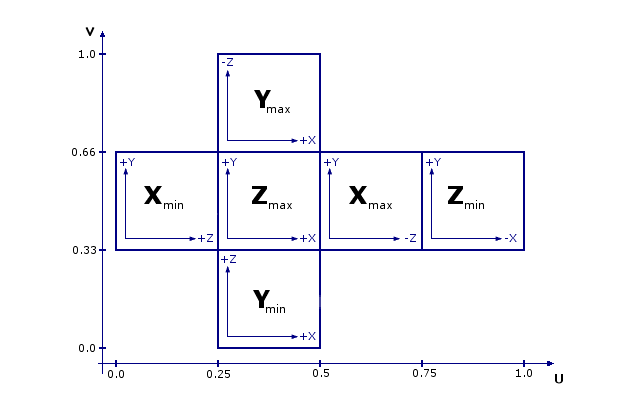
3.5.7 UV Mapping


|
3.5.6 Layered Textures |
POV-Ray 3.6 for UNIX documentation 3.5.7 UV Mapping |
3.5.8 Triangle Texture Interpolation |

|
All textures in POV-Ray are defined in 3 dimensions. Even planar image mapping is done this way. However, it is sometimes more desirable to have the texture defined for the surface of the object. This is especially true for bicubic_patch objects and mesh objects, that can be stretched and compressed. When the object is stretched or compressed, it would be nice for the texture to be glued to the object's surface and follow the object's deformations.
When uv_mapping is used, then that object's texture will be mapped to it using surface coordinates (u and v) instead of spatial coordinates (x, y, and z). This is done by taking a slice of the object's regular 3D texture from the XY plane (Z=0) and wrapping it around the surface of the object, following the object's surface coordinates.
Note: some textures should be rotated to fit the slice in the XY plane.
Syntax:
texture {
uv_mapping pigment{PIGMENT_BODY} | pigment{uv_mapping PIGMENT_BODY}
uv_mapping normal {NORMAL_BODY } | normal {uv_mapping NORMAL_BODY }
uv_mapping texture{TEXTURE_BODY} | texture{uv_mapping TEXTURE_BODY)
}
Surface mapping is currently defined for the following objects:

With the keyword uv_vectors, the UV coordinates of the corners can be controlled for bicubic patches
and standard triangle mesh.
For bicubic patches the UV coordinates can be specified for each of the four corners of the patch. This goes right
before the control points.
The syntax is:
uv_vectors <corner1>,<corner2>,<corner3>, <corner4>
with
default uv_vectors <0,0>,<1,0>,<1,1>,<0,1>
For standard triangle meshes (not mesh2) you can specify the UV coordinates for each of the three vertices uv_vectors
<uv1>,<uv2>,<uv3> inside each mesh triangle. This goes right after the coordinates (or
coordinates & normals with smooth triangles) and right before the texture.
Example:
mesh {
triangle {
<0,0,0>, <0.5,0,0>, <0.5,0.5,0>
uv_vectors <0,0>, <1,0>, <1,1>
}
triangle {
<0,0,0>, <0.5,0.5,0>, <0,0.5,0>
uv_vectors <0,0>, <1,1>, <0,1>
}
texture {
uv_mapping pigment {
image_map {
sys "SomeImage"
map_type 0
interpolate 0
}
}
}
}

|
3.5.6 Layered Textures | 3.5.7 UV Mapping | 3.5.8 Triangle Texture Interpolation |

|